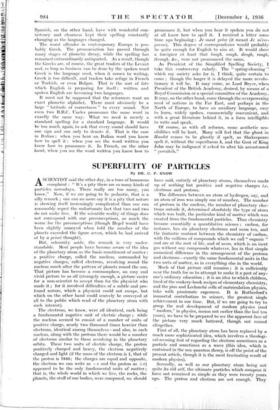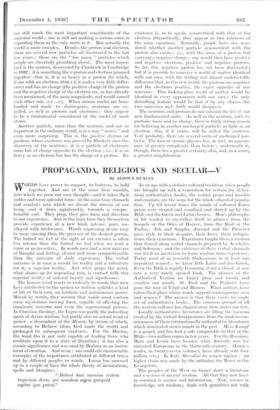SUPERFLUITY OF PARTICLES
By DR. C. P. SNOW
But, solemnity aside, the remark is very under- standable. Most people have become aware of the idea of the planetary atom as the basic constituent of matter : a positive charge, called the nucleus, surrounded by negative charges,' called electrons, revolving round the nucleus much after the pattern of planets round the sun. That picture has become a commonplace, an easy and vivid picture to us all (strangely enough, a picture easier for a non-scientist to accept than for the physicist who made it ; for it involved difficulties of a subtle and pro- found nature, which a physicist could not escape, but which on the other hand could scarcely be conveyed at all to the public which read of the planetary atom with such interest).
The electrons, we knew, were all identical, each being a fundamental negative unit of electric charge ; while the nucleus seemed to consist of a number of units of positive charge, nearly two thousand times heavier than electrons, identical among themselves—and also, in each nucleus, along with the protons there would be a number of electrons similar to those revolving in the planetary orbits. These two units of electric charge, the proton positively charged and heavy, the electron negatively charged and light (if the mass of the electron is 1, that of the proton is 1846; the charges are equal and opposite, the electron we can write as —e and the proton as +e) appeared to be the only fundamental units of matter ; that is, the whole world in which we live, the rocks, the planets, the stuff of our bodies, were composed, we should have said, entirely of planetary atoms, themselves made up of nothing but positive and negative charges i.e. electrons and protons.
The difference between an atom of hydrogen, say, and an atom of iron was simply one of number, The number of protons in the nucleus, the number of planetary elec- trons outside it, determined absolutely the type of atom which was built, the particular kind of matter which was created from the fundamental particles. Thus chemistry became essentially a quantitative science : carbon, for instance, has six planetary electrons and neon ten, and the fantastic contrast between the chemistry of carbon, with the millions of compounds which we call " organic " and are at the root of life, and of neon, which is an inert gas without any compounds whatever, lies in that simple numerical difference in the arrangement of the protons and electrons—exactly the same fundamental units in the two sorts of matter, as in everything else in the world.
Much of that picture still remains ; it is sufficiently near the truth for us to attempt to make it a part of any- one's ordinary education ; it is an idea to which children, tired of the cookery-book recipes of elementary chemistry, and the pins and Leclanche cells of matriculation physics, take with passionate eagerness. It is Rutherford's immortal contribution to science, the greatest single achievement in our time. But, if we are going to try to grasp the real development of modern physics (and " modern," in physics, means not earlier than the last ten years), we have to be prepared to see the apparent face of the picture very much battered, though not ruined altogether.
First of all, the planetary atom has been replaced by a much more sophisticated idea, which involves a theologi- cal-seeming feat of regarding the electron sometimes as a particle and sometimes as a wave (this idea, which is contained in the new quantum, theory, is off the point of the present article, though it is the most fascinating result of modern physics).
Secondly, as well as our planetary atom being not quite its old self, the ultimate particles which compose it have not remained as simple as they were twenty years ago. The proton and electron are not enough. They are still much the most important constituents of the material world ; one is still not making a serious error in regarding them as the only units in it.. But actually the world is more complex. Besides the proton and electron, there are several new particles, all discovered in the last few years ; these are the " too many " particles which people are cheerfully grumbling about. The most impor- tant is the neutron, discovered by Chadwick in Cambridge in 1932 ; it is something like a proton and electron jammed together—that is, it is as heavy as a proton (to which, if one adds an electron, 1846+1, it makes very little differ- ence) and has no charge (the positive charge of the proton and the negative charge of the electron are, as has already been mentioned, of the same magnitude, and would cancel each other out, -1-e —e). When atomic nuclei are bom- barded and made to disintegrate, neutrons are ex- pelled, as well as protons and electrons ; they appear to be a fundamental constituent of the nuclei of most atoms.
Another particle, rarer than the neutron, and not so important in the ordinary world, is in a way " newer " and even more surprising. This is the positive electron or positron, whose existence was proved by Blackctt since the discovery of the neutron ; it is a particle of electronic mass but of charge opposite to the electron ; i.e., it is as heavy as an electron but has the charge of a proton. Its existence is, so to speak, symmetrical with that of the electron (theoretically, they appear as two solutions of the same equation). _Naturally, people have also won- dered whether another particle symmetrical with the proton also exists ; i.e., with the mass of a proton but carrying a negative charge ; one would then have positive and negative electrons, positive and negative protons. So far, this negative proton has not been discovered ; but it is possible to conceive a world of matter identical with our own, with the trifling and almost undetectable difference that, in this new world, the protons are negative and the electrons positive, the exact opposite of our universe. This looking-glass world of matter would be identical in every appearance with our own ; the only disturbing feature would be that if by any chance the two universes met, both would disappear.
The neutrons and protons do not exhaust the list of our new fundamental units. As well as the neutron, with its protonic mass and no charge, there is fairly strong reason for believing in another uncharged particle, as light as au electron—this, if it exists, will be called the neutrino. Very probably, there are several sorts of uncharged par- ticles. The face of atomic physics has, in fact, an appear- ance of greater complexity than before ; underneath it, though, there lies a greater certainty also, and, in a sense, a greater simplification.





















































 Previous page
Previous page